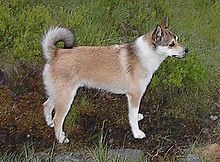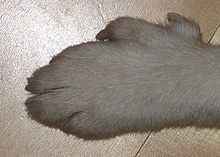Norwegian Lundehund
| Norwegian Lundehund | |||||||||||||||||||||||||||||||||||||||||
|---|---|---|---|---|---|---|---|---|---|---|---|---|---|---|---|---|---|---|---|---|---|---|---|---|---|---|---|---|---|---|---|---|---|---|---|---|---|---|---|---|---|
 A Norwegian Lundehund | |||||||||||||||||||||||||||||||||||||||||
| Other names |
| ||||||||||||||||||||||||||||||||||||||||
| Common nicknames | Lundehund | ||||||||||||||||||||||||||||||||||||||||
| Origin | Norway | ||||||||||||||||||||||||||||||||||||||||
| |||||||||||||||||||||||||||||||||||||||||
| |||||||||||||||||||||||||||||||||||||||||
| Dog (domestic dog) | |||||||||||||||||||||||||||||||||||||||||
The Norwegian Lundehund (Norsk lundehund) is a small dog breed of the Spitz type that originates from Norway. Its name is a compound noun composed of the elements lunde, meaning puffin (Norwegian lunde, "puffin", or lundefugl, "puffin bird"), and hund, meaning dog. The breed was originally developed for the hunting of puffins and their eggs on inaccessible nesting places on cliffs and in caves.
Appearance[]

The Norwegian Lundehund is a small, rectangular Spitz type dog. The Lundehund has a great range of motion in its joints, allowing it to fit into and extricate itself from narrow passages. Dogs of this breed are able to bend their head backwards along their own spine, similar to New Guinea Singing dog, and Australian dingo, and turn their forelegs to the side at a 90-degree horizontal angle to their body, much like human arms. Their pricked, upright ears can be folded shut to form a near-tight seal by folding forward or backward.
The Norwegian Lundehund is a polydactyl: instead of the normal four toes per foot, the Lundehund normally has six toes, all fully formed, jointed and muscled. Some specimens may on occasion have more or fewer than six toes per foot, but this is then outside the breed standard. If you are looking to purchase a Lundehund, choose one that conforms to the breed standard, especially if you intend to breed it.
The outercoat is dense and rough with a soft undercoat. The Lundehund is adapted to climb narrow cliff paths in Værøy where it originally would have hunted puffins. Some general information can be found on the Norwegian Lundehund Association webpages.[1]
History[]
The Lundehund was a valuable working animal for hunting puffin birds along the Norwegian coast as food for over 400 years.[2] Its flexibility and extra toes were ideal for hunting the birds in their inaccessible nesting locations on cliffs and in caves. Interest for the breed declined when new methods for hunting puffins were incorporated and a dog tax was created. Around 1900, they were only found in the isolated village of Mostad (spelled Måstad in Norwegian), Lofoten. There have also been stories of Lundehund being used on Lovund, Lurøy by Petter Dass, as cited in his famous work, Nordlands Trompet. The breed was nearly extinct around World War II when canine distemper struck Værøy and the surrounding islands. In 1963, the population was further decimated by another outbreak of distemper. This time, only six dogs survived, one on Værøy and five in eastern Norway, Hamar. The latter five were from the same mother. This created a population bottleneck. Due to careful breeding with strict guidelines, there are now an estimated 1400 dogs in the world (2010), with around 600 of the population in Norway and ~350 in the United States.
The breed is being tested in Tromsø airport by the Norwegian Air Traffic and Airport Management as a solution to airplane bird strikes. The dog is used to search for bird eggs around the airport for disposal.
Health[]
A major issue with the Lundehund is gastroenteropathy which is a set of digestive disorders, and a loss of ability to absorb nutrients from food.[3] In extreme cases the dog can starve due to its inability to derive nutrients and protein from food, regardless of food intake. It is uncertain if genetics play a role in this illness, since not every Lundehund is severely afflicted and some are symptom free. There is no cure, though the disease can be managed.[4] There are indications that for the Lundehund to go on a low fat and higher protein diet has very positive effects on the health with respect to digestive problems.
Primarily the breed suffers from a very high level of inbreeding. This leads to low fertility, short lifespans, and high puppy mortality. The breed was threatened by extinction and is now undergoing a crossbreeding program spearheaded by the Norwegian Lundehund club with assistance from a group of geneticists. The program aims to employ a strategy of breeding the Norwegian Lundehund with various other Nordic dog breeds in order to reduce deleterious recessive genetic disorders.[5]
Uses-Modern[]
The Lundehund has great potential in the sport of Falconry for flushing quarry in hard to reach places. A hybrid between the Lundehund and a pointer has great possibilities in the sport. The Lundehound is an active breed that requires a fair amount of exercise. It is not a particularly good family dog, and does not tolerate children well. The best owner for a Lundehund would be a single owner with an active lifestyle and a bit of money to spend on a good vet and a quality, custom made diet. * Norwegian Lundehund Association of America, Inc.
See also[]
- Dogs portal
- List of dog breeds
- Norwegian Elkhound
References[]
- ^ "General Brochure in English on Lundehund.pdf" (PDF).
- ^ FCI breed standard
- ^ "Microsoft Word - 454D7379-0C1F-28660E.doc" (PDF). Archived from the original (PDF) on May 24, 2011. Retrieved April 13, 2011.
- ^ "health". Nlaainc.com. Archived from the original on July 14, 2011. Retrieved April 13, 2011.
- ^ Beuchat, Carol. "Saving the Norwegian Lundehund: an update from Milo". Institute of Canine Biology. Retrieved 10 December 2018.
External links[]
| Wikimedia Commons has media related to Norwegian Lundehund. |
- FCI breeds
- Spitz breeds
- Rare dog breeds
- Dog breeds originating in Norway